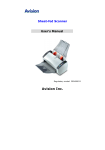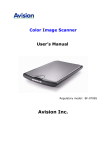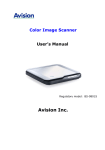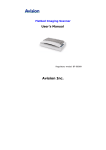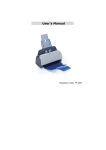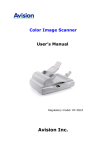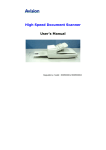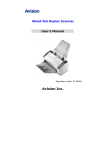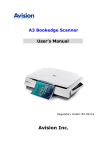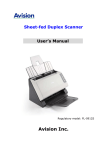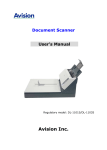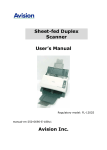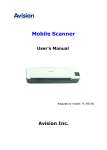Download Avision AVA6+
Transcript
Color Image Scanner User Manual Avision Inc. Regulatory model: BS-0504/ BS-0610S i Trademarks Microsoft is a U.S. registered trademark of Microsoft Corporation. Windows and MS-DOS are trademarks of Microsoft Corporation. IBM, PC, AT, XT are registered trademarks of International Business Machines Corp. Other brands and product names herein are trademarks or registered trademarks of their respective holders. Copyright All rights reserved. No part of this publication may be reproduced, transmitted, transcribed, stored in a retrieval system, or translated into any language or computer language, in any form or by any means, electronic, mechanical, magnetic, optical, chemical, manual, or otherwise, without the prior written permission of Avision Inc. Material scanned by this product may be protected by governmental laws and other regulations, such as copyright laws, the customer is solely responsible for complying with all such laws and regulations. Warranty The information contained in this document is subject to change without notice. Avision makes no warranty of any kind with regard to this material, including, but not limited to, the implied warranties of fitness for a particular purpose. Avision shall not be liable for errors contained herein or for incidental or consequential damages in connection with the furnishing, performance, or use of this material. ii FCC Radio Frequency Interference Statement This equipment has been tested and found to comply with the limits for a class B digital device, pursuant to Part 15 of the FCC rules. These limits are designed to provide reasonable protection against harmful interference in a residential installation. This equipment generates, uses, and can radiate radio frequency energy and, if not installed and used in accordance with the instruction manual, may cause harmful interference to radio communication. However, there is no guarantee that interference will not occur in a particular installation. If this equipment does cause harmful interference to radio or television reception, which can be determined by turning the equipment off and on, the user is encouraged to try to correct the interference by one or more of the following measures: Reorient or relocate the receiving antenna. Increase the separation between the equipment and receiver. Connect the equipment into an outlet on a circuit different from that to which the receiver is connected. Consult the dealer or an experienced radio/TV technician for help. CAUTION: Any changes or modifications not expressly approved by the manufacture of this device could void the user's authority to operate the equipment. iii EC Declaration of Conformity According to EN45014 Manufacturer's Name: AVISION INC. Manufacturer's Address: No. 20, Creation Road I, Science-Based Industrial Park, Hsinchu, Taiwan, R.O.C. declare that the product Model Number : BS-0504/ BS-0610S conforms to the following Product Specifications: Emission: Immunity: EN 50081-1 (1992) EN 55022 (Class B) (Conducted Radiated) (1994) EN 60555-2 (Harmonics) (1987) EN 60555-3 (Flicker) (1987) EN50082-1 (1992) IEC 1000-4-2 (ESD) (1995) IEC 1000-4-3 (RS) (1995) IEC 1000-4-4 (EFT/Burst) (1995) IEC 1000-4-5 (SURGE) (1995) iv System Requirements Windows ¾ IBM compatible PC Pentium III 600 or higher ¾ Microsoft Windows 98 / 98SE / Me / 2000 / XP ¾ USB port (Hi-Speed with USB 2.0 card only) (Compatible with USB 1.1) ¾ At least 100 MB of free hard disk space ¾ At least 128 MB of system memory ¾ A CD-ROM drive v Table of Contents 1. INTRODUCTION ...................................................................... 1-1 2. SOFTWARE INSTALLATION.............................................. 2-1 2.1 3. SCANNER INSTALLATION ................................................. 3-1 3.1 3.2 4. LOADING YOUR PAPER ....................................................... 4-1 VERIFYING YOUR SCANNER INSTALLATION ...................... 4-2 A GLANCE OF THE SCANNER PROPERTIES DIALOG BOX . 4-6 USING THE SCANNER PROPERTIES DIALOG BOX 55.1 5.2 5.3 5.4 5.5 5.6 5.7 5.8 6. REMOVING THE SHIPPING LOCK ......................................... 3-2 CONNECTING THE CABLES ................................................. 3-3 COMPLETING YOUR FIRST SCAN.................................. 4-1 4.1 4.2 4.3 5. 1 INSTALLING THE CD SOFTWARE ....................................... 2-1 BUTTONS ON THE SCANNER PROPERTIES DIALOG BOX .. 5-2 THE IMAGE TAB .................................................................. 5-4 THE COMPRESSION TAB ................................................... 5-17 THE COLOR DROPOUT TAB .............................................. 5-19 THE PAPER TAB ................................................................. 5-22 THE OPTIONS TAB ............................................................ 5-33 THE SETTING TAB............................................................. 5-38 THE INFORMATION TAB .................................................... 5-41 USING THE BUTTONS .......................................................... 6-1 6.1 6.2 6.3 INSTALLING BUTTON MANAGER LITE 2 ............................ 6-1 CHECKING THE BUTTON CONFIGURATIONS BEFORE SCANNING ........................................................................... 6-2 SCANNING FROM ONE TOUCH OF THE BUTTONS ............. 6-4 7. TECHNICAL SERVICE ........................................................... 7-1 8. SPECIFICATIONS ................................................................... 8-1 vi 1. Introduction Congratulations on your purchase of the color image scanner. Avision is one of the leading companies in the world to develop high performance sheet-fed scanners. Before you install and operate the new scanner, please take a few minutes to read through this manual. It provides proper instructions for you to unpack, install, operate and maintain the scanner. The following figure indicates the package contents. Please check all the items against your checklist. If you do not receive all the items, please contact your authorized local dealer immediately. 1-1 Scanner cover 1 4 3 1. 2. 3. 4. Main Unit USB Cable Power Adapter/cord Quick Guide/CD Package contents 1-2 2 2. Software Installation 2.1 Installing the CD Software 1. Insert the supplied CD into your CD-ROM. The installation menu appears, as shown below: Note: If the Installation menu fails to appear, an alternative method is to click the Start button on the task bar, choose Run, and type “d:\cdsetup.exe” (D: your CD-ROM drive in use) and click O.K. 2. Follow the on-screen instructions to install applications respectively. 2-1 3. Scanner Installation Precautions Keep the scanner out of direct sunlight. Direct exposure to the sun or excessive heat may cause damage to the unit. Do not install the scanner in a humid or dusty place. Be sure to use the proper AC power source. Place the scanner securely on an even, flat surface. Tilted or uneven surfaces may cause mechanical or paper-feeding problems. Retain the scanner box and packing materials for shipping purposes. Only use the AC adapter (BS-0504: SAL124A-2410U6 by Sino-American, BS-0610S: PSAA15W-120 by PHINONG, or BS-0610S: HEG42-120130-7L by HITRON) included in the machine. Using other AC adapters may damage the machine and void the warranty. 3-1 3.1 Removing the shipping lock Unlock the scanner by moving the lock switch beneath it to the “Unlock” position. (Refer to the Lock/Unlock figure as below.) Lock Unlock Lock/Unlock figure 3-2 3.2 Connecting the Cables Make sure the power of scanner is off. Connecting to Power Plug the small end of the power adaptor into the power jack of your scanner. Insert the other end to an appropriate power outlet. Power Cable 3-3 Connecting to Computer 1. Connect the square end of the USB cable to the USB port of your scanner. Connect the rectangle end to the USB port of your computer. USB Cable 3-4 2. The computer should detect a new USB device and prompt a “New Hardware Found” message. (Windows 9X/Windows ME) 3. (Windows 2000/XP) In Windows 9X or Windows ME, confirm that the “Search for a better driver.” is selected and click the “Next” button. In Windows XP, click the Next button to continue. 4. During the process, the Windows XP certification screen will appear. Ignore the contents and choose “Continue Anyway” to complete the installation. 3-5 5. When the Finish dialog is prompted, click the Finish button. (Windows 9X/Windows ME) 3-6 (Windows 2000/XP) 4. 4.1 Completing Your First Scan Loading Your Paper Align the document to the reference mark, as indicated. reference mark Document (the text face down) 4-1 4.2 Verifying Your Scanner Installation To verify if your scanner installation is correct, Avision provides you a useful test program called Avision Capture Tool. With this tool, you can perform simple scans and view the captured images. In addition, it helps you complete your scan at a rated speed. The following procedure describes how to verify your scanner installation. If the installation is not correct, please review the preceding section to check if the cable connection and scanner driver have been successfully installed. Before you begin, be sure the scanner is on. 1. Select Start>Programs>Avision AVxxx Scanner>Avision Capture Tool. The Select Scanner Model dialog box will be displayed. 2. Select your driver type and scanner model and click OK. The following Avision Capture Tool dialog box will be displayed. 4-2 Fit Actual Page Size Setup Scan File Format Save File Path 3. Choose your desired file format from the File Format drop down list box. (Default is BMP, other choice includes TIFF, GIF, and JPEG.) 4. Type your desired folder name and file name in the File Path box. (Default is C:\My Scan\Image.) Note: If you do not wish to save the scanned image, deselect the Save button since default is Save Enable. In this case, the thumbnail view will be disabled. And therefore, after viewing all the scanned images, only the last one will remain on the screen. 5. Click the Setup button ( ) or choose Setup from the File menu to prompt the Scanner Properties dialog box. 4-3 Image Selection Box 6. From the Image Selection Box, choose your desired image type for your scanned image. (Default is Front B&W) If you have a duplex scanner, choose Front and Rear to scan both sides of your document. 7. Click OK to quit the Scanner Properties dialog box. (To learn more details about the Scanner Properties dialog box, please see the subsequent chapter, Using the Scanner Properties Dialog Box.) 8. Place your document face down on the document glass or face up in the auto document feeder. 9. In the Scan Validation dialog box, click the Scan button ( ) or choose Scan from the File menu. 10. The document will be scanned and displayed in the Scan Validation screen. After the scanned images have been displayed, your scanner installation verification is completed. 4-4 Status Bar Fit Page View Thumbnail View 11. You can view the scanned image in Fit Page ( Actual Size (100%) button ( at the right side. ) or ) from the Viewing toolbars 12. Click the Close box or Quit from the File menu to exit the Scan Validation Tool. 4-5 4.3 A Glance of the Scanner Properties Dialog Box 1 2 3 4 5 6 7 8 1. Tab Options Choice: Image, Compression, Color Dropout, Paper, Options, Settings, Information. 2. Image Choose your image type and the side of Selection Box document you wish to scan. Options vary based on type of scanner. 3. Brightness: Adjust the brightness level from –100 to +100. 4. Contrast Adjust the contrast level from –100 to +100. Determine the quality of the scanned image. 5. Resolution The industry standard is 200 dpi. 6. Invert Reverse the color of your scanned image. 7. Scan Source Choice: Auto Document Feeder, Flatbed, Flatbed (Book), Automatic (varies due to different scanner model) 8. Defaults Reset all values on the tabs to the factory default settings. 4-6 5. Using the Scanner Properties Dialog Box The Scanner Properties dialog box allows you to configure the scanner’s settings. It consists of several tabbed windows each of which will be described in this chapter. The Scanner Properties dialog box 5-1 5.1 Buttons on the Scanner Properties Dialog Box The buttons on the Scanner Properties dialog box Buttons Description Defaults Click the Defaults button, the factory default settings will be shown on each tab. Scan After all the scan settings are satisfactory, click the Scan button to start scanning your document. Close Click the Close button to leave the Scanner Properties dialog box. 5-2 The following table shows the default settings: Tab name Image Default settings Image:Front B&W Binarization:Dynamic Threshold Resolution:200 dpi Invert:Blank on White Scan Source:Auto Document Feeder Threshold:None Brightness:None Contrast:None Compression None Color Dropout None Paper Cropping:Automatic Deskew:Yes Orientation:Portrait OverScan:0.00 Multifeed Detection:None Unit:Inch Options Rotation Degrees:None Blank Page Removal:None Edge Fill:White,0 mm Image Control Option:None Setting Enable Energy Saver:Enable, 15 minutes after last scan action Show Scanning Progress:Yes Show Warning Message:Yes Save Settings after Closing:Yes 5-3 5.2 The Image Tab The Image tab allows you to choose the front side and (or) the rear side of your document, the type of image, and to set several basic scan settings. Note that except for the resolution, you can set individual scan settings for the front side and the rear side. For example, all settings in the Image tab, Compression tab, Color Dropout tab can be set individually for the front and the rear side. However, the settings in the Paper tab, the Option tab, and the Setting tab have to be set the same for the front and rear side. The Image tab dialog box 5-4 5.2.1 The Image Selection Box The Image Selection box includes the image type and document side option. If you wish to scan both the front side and the rear side of your color document, you can check both Front Color and Rear Color at the same time. Note the options vary based on type of scanner. Example 1:Scanning a two-sided color document, both sides in color Side/Image Selection Front 5-5 Rear Example 2:Scanning a two-sided color document, one in B&W(Drop Blue Color:Threshold:10, Background: 79), the other in color Side/Image Selection Image Type Color Gray B&W B&W Front Rear Description Choose Color if you wish to scan a color image for your original in color. Choose Gray image if your original contains actual shades of gray. Choose B&W if your original contains only text pencil or ink sketch. Gray Color 5-6 5.2.2 Other Image Options Binarization This is the process of converting a grayscale or color image to a bi-tonal image. There are several different methods of performing this conversion. Two of the options are Dynamic Threshold and Fixed Processing. Dynamic Threshold: Selecting Dynamic Threshold allows the scanner to dynamically evaluate each document to determine the optimal threshold value to produce the highest quality image. This is used to scan mixed document containing faint text, shaded background, or color background with a single setting. If Dynamic Threshold is selected, Threshold, Brightness, and Contrast are not available. Fixed Processing: Used for black-andwhite and other high contrast documents. A single level is set to determine the black-and-white transition. The threshold is programmable over the entire density range. Fixed Processing sets Contrast to 0. If Fixed Processing is selected, Contrast is not available. Quality When you choose “Gray” to be your image type, the “Binarization” item will be changed to “Quality” and its option includes “High” and “Normal”. Choose “High” to enhance your image and make your image look brighter. 5-7 Threshold Used to convert a grayscale image to a bi-tonal image. The value ranges from 0 to 255. A low threshold value produces a lighter image, and can be used to subdue backgrounds and subtle, unneeded information. A high threshold value produces a darker image, and can be used to help pick up faint images. Adjust the threshold setting by dragging the Threshold sliding bar to the left or right to achieve the desired threshold setting. 200 dpi, Threshold:80, Brightness: 0 200 dpi, Threshold:170, Brightness: 0 5-8 Brightness Adjusts the lightness or darkness of an image. The higher the value, the brighter the image. Drag the slider to the right or left to increase or decrease the brightness. Contrast Adjusts the range between the darkest and the lightest shades in the image. The higher the contrast, the bigger the different grayscale. Drag the slider to the right or left to increase or decrease the contrast. The range is from –100 to +100. The range is from –100 to +100. Brightness: -50 Brightness: 0 (Normal) Brightness: +50 Contrast: -50 Contrast: 0 (Normal) Contrast: +50 5-9 Resolution A good control of the resolution results a good detail of an image that scans. The resolution is measured by dots per inch (dpi). Normally, the greater the dpi number, the higher the resolution and the image file size. Be aware that greater resolution takes more time to scan, and more disk space for the scanning image. For your information, an A4 size color image scanned at 300 dpi at True Color mode consumes approximately 25 MB of disk space. A higher resolution (usually means over 600 dpi) is only recommended when you need to scan a small area at True Color mode. Choose a resolution value from the drop down list. The default value is 200 dpi. Available resolutions are 75, 100, 150, 200,300, 400 and 600. Or you may choose your desired value by clicking the box in the right side of the drop down list and press the arrow key to select your desired value and then click the Add button to include it in the drop down list. Resolution: 75 dpi Resolution: 150 dpi 5-10 Invert Reverses the brightness and the colors in the image. The default setting is Black on a White background. Reverse mode is White on a Black background. For color images, each pixel will be changed into its complementary color at the command of Invert. Black on White White on Black 5-11 Scan Source Choice: y Auto Document Feeder: Used to scan multiple pages. y Flatbed: Used to scan a single page. For example, pages from newspaper clipping, paper with wrinkles or curls. y Flatbed (book): Used to scan several inside pages from book. y Automatic: Allow the scanner automatically set its scan source. If Automatic is selected and there is document in both the auto document feeder (ADF) and the flatbed, then the scan source will be automatically set to ADF. If Automatic is selected and there is document only in flatbed, then the scan source will be set to flatbed. Note the options vary based on type of scanner. 5.2.3 Scanning color images The following options are available for scanning color images. y y y y Brightness Contrast Resolution Invert 5.2.4 Scanning grayscale images The following options are available for scanning gray images. y y y y Brightness Contrast Resolution Invert 5-12 5.2.5 Scanning B&W images The following options are available for scanning B&W images. y y y Or y y y y y Binarization (Dynamic Threshold) Resolution Invert Binarization (Fix Processing) Threshold Brightness Resolution Invert 5-13 5.2.6 Editing Profiles The Scanner Properties dialog box allows you to change and save your frequently used scan settings into a profile. You can edit these profiles by renaming or deleting them. To add a new profile, 1. 2. Customize your settings. (For example, change your resolution, image type, cropping method, scan size, or other scan settings.) Click the Image tab and then choose “Profiles” to prompt the “Edit Your Profile” dialog box. 3. Click “Add” to enter the name of the profile and then choose “Save”. 4. The new profile will be saved and shown in the “Profiles” dropdown list box. 5-14 To load a profile, 1. From the Image tab dialog box, choose your favorable profile from the “Profiles” dropdown list box. 2. Your favorable profile will be immediately loaded and displayed on Scanner Properties dialog box. To delete a profile, 1. From the Image tab dialog box, click “Profiles” to prompt the Edit Your Profile dialog box. 2. Choose the profile you want to delete from the dropdown list box. Click “Delete”. A Confirm message “Are you sure you want to delete this profile?” is prompted. Choose “Yes” to delete or “Cancel” to quit. 3. 4. 5-15 To rename a profile, 1. From the Image tab dialog box, click “Profiles” to prompt the Edit Your Profile dialog box. 2. Choose the profile you want to rename from the dropdown list box and then click the Rename button. 3. Enter new name for the profile. 4. Choose “Save” to save the new profile or “Cancel” to quit. Note: The preset default profiles include Flatbed, Simplex-B&W, 200 dpi, Simplex-Gray, 200 dpi, Simplex-Color, 200 dpi, DuplexB&W, 200 dpi, Duplex-Gray, 200 dpi, Duplex-Color, 200 dpi. If you have a simplex or a sheetfed scanner, the duplex or the flatbed option will not be available. 5-16 5.3 The Compression Tab The Compression tab allows you to compress your scanned image and choose the level of compression. Bi-tonal images are normally compressed using CCITT standard called Group 4 (G4). Color and grayscale images are often compressed using JPEG technology. Move the JPEG Quality slider to the right or left to increase or decrease the level of compression. Note the greater the compression level, the lower image quality. Default is 50%. Note that the compression depends on your image editing application. If your image editing application does not support the type of compression format, then either a warning message will appear or the image quality of the compressed file will not be acceptable. JPEG (Joint Photographic Editor Group). This group developed and lent their name to a file compression standard for color and grayscale images that is widely used by scanners, and software applications. On Microsoft Windows-based systems, a file with the extension .jpg has normally been compressed using this standard. For scanning color or gray images, the following compressions are available: y None y JPEG For scanning B&W images, the following compressions are available: y None y G4 5-17 The Compression tab dialog box 5-18 5.4 The Color Dropout Tab 5.4.1 Color Dropout Selection Color Dropout tab allows you to drop either of the red, blue, or green color in your scanned image. If your image contains red color watermark or background, choose the R (Red) channel then any red watermark or background will be removed. This feature is used to sharpen your text when using OCR (Optical Character Recognition) software. Note that this function supports only black & white and gray images. Therefore, be sure to choose any black & white or gray image type while applying this function. The Color Dropout dialog box 5-19 5.4.2 Other Color Dropout Options Advanced Processing provides two options that can adjust your scanned image in the best optimal result. Filter Threshold This value is used to determine the color which will be dropped out. A lower value will drop more of the selected color out, while a higher value will leave more of the selected color in. Background Level The pixel which is higher than the background value will be adjusted to the lightest point. Adjust the value for both the Filter Threshold and Background Level to produce the best optimal result. Example, slightly adjusting the background value makes your text more clear. Original 5-20 Remove Blue, Threshold: 20, Background: 255 Remove Blue, Threshold: 20, Background Level: 210 5-21 5.5 The Paper Tab The Paper tab allows you to define values relating to image output (i.e., Auto Crop or not, Scan Area, OverScan, Multi-Feed Detection). The Paper tab dialog box 5-22 5.5.1 Cropping Cropping allows you to capture a portion of the document being scanned. Choice: Automatic, Fixed to Transport, EOP (End of Page) Detection. Options Description Automatic Automatic adjusts the cropping window according to different document sizes. Use this option for batches of mixed-sized documents. Fixed to Transport This feature allows you to define the area or zone to be imaged. Use for batches of same-sized documents. If you select this option, you can use the arrow keys to define the x and y offset values, width and length to redefine your scanned area. The Display window will show image placement as you change the values. EOP (End of Page) Detection This feature allows you to define the area or zone to be imaged. Use for batches of same-width but different length documents. If you select this option, you can use the arrow keys to define the x and y offset values, width and length to redefine your scanned area. The Display window will show image placement as you change the values. 5-23 The following options are only available when Fixed to Transport is selected. y X-Offset — the distance from the left end of the scanner to the left edge of the scanning area. y Y-Offset — the position from the top end of the document to the top end of the scanning area. y Width — the width of the scanning area. y Length — the length of the scanning area. y Center: automatically calculates the x-offset for centerfed feeding based upon document size selected. y — relocate the scan area by click the arrow key on the cross sign while retain the scan size. View the result from the Display window. 5-24 Example: Redefine your scan area ( x-offset: 2.25 inches;yoffset:1.13 inches) Scan Area Display window After Fixed to Transport Original The Redefined Scan Area 5-25 5.5.2 Other Paper Selection Deskew Use this option to automatically deskew a document. Note: If the skew angle is too great, some of the image may be cut off. Scan Area Choose your desired paper size with the drop-down list box. Or you may select a custom paper size by clicking the Scan Area box and then click Add to include in the choice. Choice: None, US Letter- 8.5”x 11”, US Legal – 8.5” x 14”, ISO A4 – 21 x 29.7 cm, ISO A5 – 14.8 x 21 cm, ISO A6 – 10.5 x 14.8cm, ISO A7 – 7.4 x 10/5 cm, ISO B5 – 17.6 x 25 cm, ISO B6 – 12.5 x 17.6 cm, ISO B7 – 8.8 x 12.5 cm, JIS B5 – 18.2 x 25.7 cm, JIS B6 – 12.8 x 18.2 cm, JIS B7 – 9.1 x 12.8 cm, Scanner Maximum, Long Page. Long Page: When you need to scan documents whose length exceeds scanner maximum, please choose Long Page. Note if Long Page is selected, the Multi-Feed Detection will not be available. Options: Unlimited, Enter Length (Note: This option varies due to type of scanner.) 5-26 Choose “Unlimited” if you have a batch of long page document with unknown length. Choose “Enter Length” to enter the length and width of your documents or your desired scan size on documents. This is useful when you have a batch of documents with the same scan size or a batch of same-sized documents. OverScan Overscan allows you to add a specific margin at top and bottom or right and left (Options vary based on the type of scanner) of the edge of the image. This is used to reduce possible corner clipping on the skewed images and often applied to a batch of skewed document to be scanned in the auto document feeder. Select a value between 0 and +5 mm. Note the overscan result will not be shown in the Display window and that the availability of the function varies based on type of scanner. Multi-Feed Detection Multi-Feed Detection allows you to detect overlapped document that go through the auto document feeder. Multi-Feed usually occurs due to stapled documents, adhesives on documents, or electro-statically charged document. Note: The availability of the function varies based on type of scanner. Additional Length Detection Additional Length Detection allows you to define the length of document being multi-fed. This value indicates the additional length exceeding your scan area. The Display window will show the size of the document as you change the value. A value of 0 indicates no additional length detection. The Additional Length Detection is best used when scanning samesize documents in the auto document feeder. 5-27 Example:Additional Length Detection:Set Additional Length to be 2.02 inches 2.02” There are two options available if Multi-Feed is detected. z z Stop Scanning after Multi-Feed If this is selected, the scanner will stop the feeder if multifeed is detected. Sound Alarm on Multi-Feed: If this is selected and a wave file is added, the scanner will produce a sound alarm if multi-feed is detected. 5-28 How to add the sound alarm: 1. Click the Browse button on the right side of the speaker icon. The Open dialog box appears. 2. Choose your wave file. 3. Click the Open button. The wave file is added. Units Defines the primary measurement system. Inches, Millimeters, and Pixels are available. 5-29 5.5.3 Relative to Document Relative to Document: (used for batches of same-sized documents) This option allows you to crop different areas on your documents and deliver these images in B&W, Gray, or Color separately. For example, there are applications which require you to store the entire document in B&W and a part of the document in color to save storage space. This is useful for documents where a photograph, or signature appears in a consistent area on the document such as resumes, and so on. The following procedure describes how to reproduce the entire document in B&W and a portion of document (picture) in color. 1. On the Paper tab, choose “Relative to Document” or “Fixed to Transport” from the Cropping option. 2. Choose your scan size from the Scan Area option. The selected scan size will be displayed in a red rectangular box. This is also the scan size of your entire document. (For example, ISO B5. If you have not chosen a scan area and leave the selection as None, then the default area will be the scanner’s maximum.) 1 A red rectangular box 2 5-30 3. Click the Preview tab to display the Preview window. A black rectangular box appears to indicate the max. scan size your have just selected. The selected image The Image Selection Box A black rectangular box 4. Click the Preview button to view the entire image in low resolution to correctly crop your relative scan area. The Preview Image The Preview Button 5. Select image type from the Image Selection box. The selected image will appear in highlighted color. (For example, Front Color) 6. Place your cursor on the Preview window and click your left mouse button. A cross sign will appear as illustrated. Create your relative scan size diagonally by dragging the left mouse button to your preferable size. The selected area will appear in a red box as illustrated. 5-31 A Cross Sign 7. 8. The Relative Area Check the B&W image from the Image Selection box to scan the entire document. Click the Scan button to start scanning the document in two image types and sizes. (See the result in below.) The entire document in B&W 5-32 The relative area in color 5.6 The Options Tab The Options tab allows you to set following additional image processing settings. The Option tab dialog box 5-33 Flip Side Rotation Select “fanfold” to rotate the image of the reverse side to 180 degrees. This is applied to double-sided document which are viewed in portrait are sometime fed into the scanner in landscape or vice versa. Choice: Book, Fanfold. If “Book” is selected, the image of the reverse side will not be rotated. The following illustration shows the documents which should be viewed in portrait are fed into the scanner in landscape 5-34 Rotate Image Choose the rotation angle from the drop down list if you wish to rotate your scanned image. Choice: None, 90°CW(clockwise), 90°CCW(counter clockwise), 180°. Original Rotate 90°CCW Blank Page Removal Rotate 90°CW Rotate 180° Check if you wish to remove the blank page and move the slider to the left or right to your desired threshold. 5-35 Edge Fill Check White or Black if you wish to add white or black edge on the border of your scanned image. Enter the value from 0 to 5 mm. Default value is 0. Original Image Control Option Edge Fill: 5mm (Black) Check the Mirror box if you wish to reverse the right and left side of your image. Original The Mirror Effect 5-36 Background Setting This option allows you to set your scan background. Choice: White Background, Black Background. *This option varies based on type of scanner and is available for the front page in the ADF (auto document feeder) only. For the rear page, only the white background is available. White Background Black Background 5-37 5.7 The Setting Tab The Setting tab allows you to set the following settings: The Setting tab dialog box Energy Saving Control Check the Enable Energy Saver box and move the slider to the right to set the amount of time to start the energy saver after your last action. The range is from 1 to 720 minutes. The default is 15 minutes. 5-38 Batch Scan Setting •Batch Scan To increase the scanning speed, the scanner first scans a few pages of your document and then sends these scanning data to the application. Therefore, during scanning, the numbers of pages been scanned on the scanner is somehow different with the numbers of pages displayed on your computer screen. Choose this mode if you wish to complete your scanning task at the fastest speed. •Page Scan If you choose Page Scan, during scanning, the scanner will first scan only one page of your document and then send the scanned data to the application and then scan the next page and send the next data to the application, and so on. Therefore, in this mode, the scanning speed is slower yet this helps to keep the same scanning progress between the scanner and your computer screen. Show Scanning Progress Note: The availability of this feature varies based on type of scanner. Check and the scanning progress bar will be shown during scanning. 5-39 Show Warning Message Check to show the warning messages such as “ADF pad count exceeds 50,000 scans (the number varies based on type of scanner). Please replace the ADF pad and reset the pad count.” Save Settings after Closing Check to save your scanner properties settings after leaving the dialog box. Next time when you open the Scanner Properties dialog box, the previously saved settings will be shown. 5-40 5.8 The Information Tab The Information tab displays the following system and scanner information. The Information tab dialog box The “Report” button: If you encounter any error message while using the scanner, click the Report button. A report.txt file (C:\AVxxx) will be generated. Please send this file to the nearest service center for trouble shooting. 5-41 The “Reset Pad Count” button」: After scanning approximately 50,000 pages (the number varies based on type of scanner) through the Auto Document Feeder (ADF), the ADF pad may be worn out and you may experience problems with document feeding. In this case, it is highly recommended to replace the ADF pad with a new one. (Please refer to the manual for proper replacing procedure.) For ordering the ADF pad, please consult your nearest dealer. After replacing the ADF pad, click the “Reset Pad Count” button to reset the pad count. The “Reset Roller Count” button」: After scanning approximately 200,000 pages (the number varies based on type of scanner) through the ADF, the ADF roller may be worn out and you may experience problems with document feeding. In this case, it is highly recommended to replace the ADF roller with a new one. (Note the replacement of the ADF roller has to be performed only by authorized service center. Therefore, please return your scanner for roller replacement.) After replacing the ADF roller, click the “Reset Roller Count” button to reset the roller count. Note: The lifetime and the replacing procedure vary based on type of scanner. Please consult your nearest dealer for more details. 5-42 6. Using the Buttons The following picture shows the 2 buttons on the scanner. ID Card ID Photo 6.1 Installing Button Manager Lite 2 To use the buttons on the scanner, you need to install the Button Manager. To ensure the Button Manager work properly, please FIRST install Button Manager before installing the scanner driver. Installing the Button Manager is easy. Insert the supplied CD to your CD-ROM drive and follow the instructions on the screen to complete the installation of the Button Manager. Button Manager provides you an easy way to scan your document and then link the scanned image to your designated software application. All this can be done by a simple touch of the button on the scanner. Yet, before you scan, it is recommended to check the button configurations first to ensure a proper file format and a destination application. 6-1 6.2 Checking the Button Configurations Before Scanning 1. Click the Scan button on the scanner. 2. The Button Panel is displayed in the Windows System Tray at the bottom right corner of your computer screen. This indicates the scanner model The Function Icon (The number of function icons vary based on type of scanner.) The Button Icon 6-2 3. Right-click the button (function) you wish to check. The Button Properties window appears. Click to select options or setting. The button name. The scan settings for the selected button. The destination application. (This is the application that opens after you have finished scanning.) The file format of the scanned image. (*The options vary based on type of scanner.) The default setting is indicated in highlighted color. If you wish to change the setting, use this window to reset the setting for the file format, destination application, or other scan settings. See “Configuring the Button” in the subsequent section to reset the settings. 4. Click the OK button to leave the window. 6-3 6.3 Scanning From One Touch of the Buttons ID Card ID Photo 1. Press the button you desire. 2. Scan and load your scanned image to your default image editing software application. 6-4 7. Technical Service Before contact Avision, please prepare the following information: Scanner serial & revision number (located on the bottom of the scanner); Hardware configuration (e.g., your host CPU type, RAM size, free disk space, display card, interface card); The name and version of your scanning software application; The version of your scanner driver. Please call us at: Headquarter Avision Inc. No. 20, Creation Road I, Science-Based Industrial Park, Hsinchu 300, Taiwan, ROC TEL: +886 (3) 578-2388 FAX: +886 (3) 577-7017 E-MAIL: [email protected] Web Site: http://www.avision.com.tw US and Canada Area Avision Labs, Inc. 6815 Mowry Ave., Newark CA 94560, USA TEL: +1 (510) 739-2369 FAX: +1 (510) 739-6060 E-MAIL: [email protected] Web Site: http://www.avision.com 7-1 8. Specifications All specifications are subject to change without notice. Model Number BS-0504/ BS-0610S Scanner Type: Optical Resolution: Scanning Modes: Desktop flatbed 600 dpi * 1200 dpi Black & White mode 8-bit gray scale 24-bit color Max. Document Size: Interface: 105mmx175mm USB Power Requirement: 24Vdc/0.8A (BS-0504) 12Vdc/1.25A (BS-0610S) 12W 283 mm x 160 mm x 55 mm 855.10g Power Consumption: Dimensions: (WxHxD) Net Weight: 8-1





































































